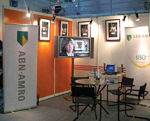What the Future Holds
March 31, 08
It’s not enough just to have one life anymore; second lives, lived entirely online, are becoming increasingly prevalent. In “Second Life,” the popular virtual world launched in 2003 by Linden Research Inc., people can live their entire lives online, and many are doing just that.
Second Life allows its “Residents” to create online personas, known as “avatars,” and to network and interact with thousands of other virtual inhabitants. But this is networking at its most sophisticated level yet, and the virtual world is host to its own trading and financial world. The money generated by Residents, Linden dollars (L$), is anything but virtual and can be exchanged for “real world” currencies.
Although all of this might seem like the stuff of a science fiction novel, the virtual online world is becoming big business. While there are some businesses that exist solely in their online guises, there are a growing number of companies that have taken the plunge into the virtual world to ensure that they snare a fair share of this growing market. Some of the businesses holding real estate online are hardly those that you would expect to see.

ABN AMRO, the Belgian bank and a large lender to the diamond industry, has a virtual bank. American Apparel opened a branch inside the virtual world selling digital renderings of clothing modeled after real-life merchandise, while Reuters has a news bureau that reports news in the virtual universe.
While these commercial uses may seem like a logical extension of “First Life” economics, businesses are also using Second Life to bring together disparate workers, hold meetings and put on special events. The American Cancer Society held a version of its “Relay For Life” national fundraising event online. BBC Radio 1 recreated the 2006 One Big Weekend event on a 64 acre virtual island in Second Life. In 2006, Harvard Law School and Harvard Extension School offered a course called “CyberOne: Law in the Court of Public Opinion” within Second Life. Leo Burnett Worldwide has established a creative hub in Second Life to allow globally dispersed staff to interact. PA Consulting Group uses Second Life to host virtual conferences, recruitment events and as a tool for its clients to simulate new product and service offerings.
The potential is even there for entire industries to hold trade events online. Just ask the American Institute of Architects. While the association held its regular, physical show, in San Antonio, Texas in 2007, online attendees to the conference could access press events, seminars, and other webcasts from the show floor. The virtual attendance was made possible by exhibitor Autodesk, which makes architectural software. Writing on tgdaily.com, Mark Raby said, “Second Life users who visit Autodesk’s virtual booth will literally be able to interact with conference speakers in the same capacity as attendees sitting in the room.”
According to research carried out by The FactPoint Group, on behalf of Unisfair, as of September 2007, virtual events attract an average of 1,587 attendees and due to increased attendance and the availability of detailed marketing data, deliver 348 qualified leads per each event sponsor.
The FactPoint Group’s findings also showed that attendees typically spend 2.5 hours at a virtual event, visit 16 locations and download five resources. Interactivity is fostered among attendees, presenters, panelists, sponsors and exhibitors in real-time through multimedia, including text, audio, video and voice technologies and on average, attendees engage in 13 interactions via chat or e-mail. It certainly seems to be an effective way of doing business.
One of the big advantages of virtual trade shows is that while the standard duration of a Unisfair virtual event is 1.5 days, most virtual events remain available to prospects on demand for 90 days in order to continue to deliver valuable resources. So, while you have already moved onto the next event, potential clients can still learn all about you without the need for you to actually be present. Even more importantly, as green issues become increasingly important, virtual events help to drastically reduce carbon footprints.
In addition, global reach is easily extended, as international attendees have accounted for 42 percent of the virtual audiences, compared to 58 percent of U.S. attendees.
“Virtual worlds and social networking are receiving a lot of attention these days,” said Guy Piekarz, CEO of Unisfair. “We have taken these concepts and applied them to solve real world business challenges – giving marketing a new way to create demand for their products, extend their market reach and increase brand awareness.”
It remains to be seen if online events could ever replace the traditional trade show. After all, the diamond and jewelry business is built to such a large extent on the need to actually touch and see the items in question, but with the way technology is developing, online shows could develop as another, complimentary tool to drive to drive business. It’s certainly something for the industry to start thinking about.